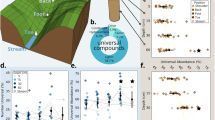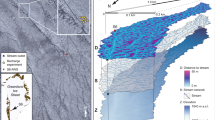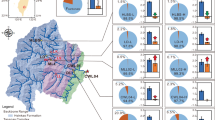Abstract
Besides their role in the hydrological cycle1, glaciers could play an important role in the carbon cycle2,3,4,5,6. They store and transform organic carbon5,6, which on release could support downstream microbial life3. Yet the origin and composition of glacial organic carbon, and its implications for the carbon cycle, remain unclear. Here, we examine the molecular composition, radiocarbon age and bioavailability of dissolved organic matter (DOM) in 26 glaciers in the European Alps, using ultrahigh-resolution mass spectrometry, fluorescence spectroscopy and incubation experiments. We also measure carbon dioxide partial pressures in glacier-fed streams. We show that the glacier organic matter is highly diverse, and that a significant fraction of this material is bioavailable. Phenolic compounds derived from vascular plants or soil dominate, together with peptides and lipids, potentially derived from in situ microbial communities. Combustion products, in contrast, seem to contribute only marginally to the DOM sampled. We further show that organic matter bioavailability is positively correlated with in-stream carbon dioxide concentrations. We suggest that glacier-derived DOM contributes to downstream carbon cycling in glacier-fed streams. Our findings highlight the relevance of mountain glaciers for carbon cycling—a role that may change as glaciers recede.
This is a preview of subscription content, access via your institution
Access options
Subscribe to this journal
Receive 12 print issues and online access
$259.00 per year
only $21.58 per issue
Buy this article
- Purchase on Springer Link
- Instant access to full article PDF
Prices may be subject to local taxes which are calculated during checkout




Similar content being viewed by others
References
Jacob, T., Wahr, J., Pfeffer, W. T. & Swenson, S. Recent contributions of glaciers and ice caps to sea level rise. Nature 482, 514–518 (2012).
Hodson, A. et al. Glacial ecosystems. Ecol. Monogr. 78, 41–67 (2008).
Hood, E. et al. Glaciers as a source of ancient and labile organic matter to the marine environment. Nature 462, 1044–1047 (2009).
Stubbins, A. et al. Anthropogenic aerosols as a source of ancient dissolved organic matter in glaciers. Nature Geosci. 5, 198–201 (2012).
Anesio, A. M. & Laybourn-Parry, J. Glaciers and ice sheets as a biome. Trends Ecol. Evol. 27, 219–225 (2012).
Anesio, A. M., Hodson, A. J., Fritz, A, Psenner, R. & Sattler, B. High microbial activity on glaciers: Importance to the global carbon cycle. Glob. Change Biol. 15, 955–960 (2009).
Haeberli, W., Paul, F. & Zemp, M. Vanishing glaciers in the European Alps. Pontific. Acad. Sci., Scr. Varia 118 (in the press).
Milner, A. M, Brown, L. E & Hannah, D. M. Hydroecological response of river systems to shrinking glaciers. Hydrol. Process. 23, 62–77 (2009).
Preunkert, S. et al. Quantification of dissolved organic carbon at very low levels in natural ice samples by a UV-induced oxidation method. Environ. Sci. Technol. 45, 673–678 (2011).
Hansell, D. A., Carlson, C. A., Repeta, D. J. & Schlitzer, R. Dissolved organic carbon in the ocean. Oceanography 4, 202–211 (2009).
Volk, C. J., Volk, C. B. & Kaplan, L. A. Chemical composition of biodegradable dissolved organic matter in streamwater. Limnol. Oceanogr. 42, 39–44 (1997).
Anderson, M. J. & Willis, T. J. Canonical analysis of principal coordinates: A useful method of constrained ordination for ecology. Ecology 84, 511–525 (2003).
Koch, B. P., Witt, M., Engbrodt, R., Dittmar, T. & Kattner, G. Molecular formulae of marine and terrigenous dissolved organic matter detected by electrospray ionisation Fourier transform ion cyclotron resonance mass spectrometry. Geochim. Cosmochim. Acta 69, 3299–3308 (2005).
Sleighter, R. L. & Hatcher, P. G. Molecular characterization of dissolved organic matter (DOM) along a river to ocean transect of the lower Chesapeake Bay by ultrahigh resolution electrospray ionization Fourier transform ion cyclotron resonance mass spectrometry. Mar. Chem. 110, 140–152 (2008).
Bhatia, M. P., Das, S. B., Longnecker, K., Charette, M. A. & Kujawinski, E. B. Molecular characterization of dissolved organic matter associated with the Greenland ice sheet. Geochim. Cosmochim. Acta 74, 3768–3784 (2010).
Hernes, P. J. et al. Tannin diagenesis in mangrove leaves from a tropical estuary: A novel molecular approach. Geochim. Cosmochim. Acta 65, 3109–3122 (2001).
Davis, B. A. S., Brewer, S., Stevenson, A. C. & Guiot, J. The temperature of Europe during the Holocene reconstructed from pollen data. Quat. Sci. Rev. 22, 1701–1716 (2003).
Thevenon, F., Anselmetti, F. S., Bernasconi, S. M. & Schwikowski, M. Mineral dust and elemental black carbon records from an Alpine ice core (Colle Gnifetti glacier) over the last millennium. J. Geophys. Res. 114, D17102 (2009).
Bardgett, R. D. et al. Heterotrophic microbial communities use ancient carbon following glacial retreat. Biol. Lett. 3, 487–490 (2007).
Grannas, A. M., Hockaday, W. C., Hatcher, P. G., Thompson, L. G. & Mosley-Thompson, E. New revelations on the nature of organic matter in ice cores. J. Geophys. Res. 111, D04304 (2006).
Wang, D-Z., Dong, H-P., Xie, Z-X., Dai, M-H. & Hong, H-S. Metaproteomic characterization of dissolved organic matter in the water column of the South China Sea. Limnol. Oceanogr. 56, 1641–1652 (2011).
Dittmar, T. The molecular level determination of black carbon in marine dissolved organic matter. Org. Geochem. 39, 396–407 (2008).
Battin, T. J. et al. The boundless carbon cycle. Nature Geosci. 2, 598–600 (2009).
Butman, D. & Raymond, P. A. Significant efflux of carbon dioxide from streams and rivers in the United States. Nature Geosci. 4, 839–842 (2011).
Mulholland, P. J. Dissolved organic matter concentration and flux in streams. J. N. Am. Benthol. Soc. 16, 131–141 (1997).
Del Giorgio, P. A & Cole, J. J. Bacterial growth efficiency in natural aquatic systems. Annu. Rev. Ecol. Syst. 29, 503–541 (1998).
Cole, J., Caraco, N. F., Kling, G. W. & Kratz, T. K. Carbon dioxide supersaturation in the surface waters of Lake Jonathan. Science 265, 1568–1570 (1994).
Stedmon, C. A. & Bro, R. Characterizing dissolved organic matter fluorescence with parallel factor analysis: A tutorial. Limnol. Oceanogr. Methods 6, 572–579 (2008).
Koch, B. P., Dittmar, T., Witt, M. & Kattner, G. Fundamentals of molecular formula assignment to ultrahigh resolution mass data of natural organic matter. Anal. Chem. 79, 1758–1763 (2007).
WGMS Glacier Mass Balance Bulletin No. 10 (2006–2007) Haeberli, W., Gärtner-Roer, I., Hoelzle, M., Paul, F. & Zemp, M. (eds), ICSU (WDS)/IUGG (IACS)/UNEP/UNESCO/WMO, World Glacier Monitoring Service (2009).
Acknowledgements
We are most grateful to C. Preiler, G. Steniczka, C. Müllegger, B. Pree, A. Teufl, K. Keiblinger and I. Ulber for laboratory assistance. C. Preiler, L. Hartmann, J. Liebl, B. Eichelberger, B. Preiler, I. Hödl, B. Behounek and A. Loeckher assisted in the field or laboratory. M. Zemp and A. Fischer provided mass loss data. The manuscript benefited from comments by H. Peter and N. Burns. Financial support came from the Austrian Science Fund (START Y420-B17) to T.J.B.
Author information
Authors and Affiliations
Contributions
G.A.S., C.F. and T.J.B. conceived and designed the research. G.A.S. and L.W. organized and coordinated fieldwork. C.F. conducted all bioassays, fluorescence spectrometry, and radiocarbon dating assisted by P.S. G.A.S. ran all FT-ICR-MS analyses guided by T.D. and J.N. J.N. performed BPCA analyses. G.A.S. performed all statistical analyses assisted by C.F. T.J.B. wrote the manuscript with significant assistance from G.A.S. and C.F. All authors commented on the manuscript.
Corresponding author
Ethics declarations
Competing interests
The authors declare no competing financial interests.
Supplementary information
Supplementary Information
Supplementary Information (PDF 3115 kb)
Rights and permissions
About this article
Cite this article
Singer, G., Fasching, C., Wilhelm, L. et al. Biogeochemically diverse organic matter in Alpine glaciers and its downstream fate. Nature Geosci 5, 710–714 (2012). https://doi.org/10.1038/ngeo1581
Received:
Accepted:
Published:
Issue Date:
DOI: https://doi.org/10.1038/ngeo1581
This article is cited by
-
Global emergent responses of stream microbial metabolism to glacier shrinkage
Nature Geoscience (2024)
-
A review of physicochemical properties of dissolved organic carbon and its impact over mountain glaciers
Journal of Mountain Science (2024)
-
The evolution of stream dissolved organic matter composition following glacier retreat in coastal watersheds of southeast Alaska
Biogeochemistry (2023)
-
Bacterial communities in surface and basal ice of a glacier terminus in the headwaters of Yangtze River on the Qinghai–Tibet Plateau
Environmental Microbiome (2022)
-
Genomic and metabolic adaptations of biofilms to ecological windows of opportunity in glacier-fed streams
Nature Communications (2022)



